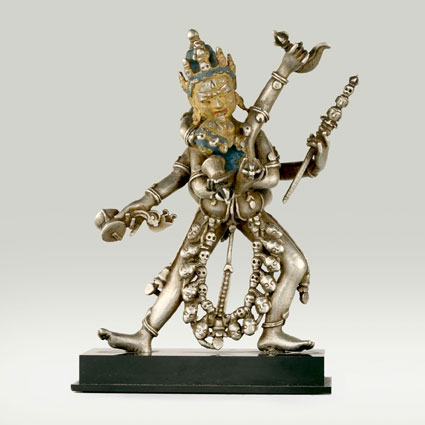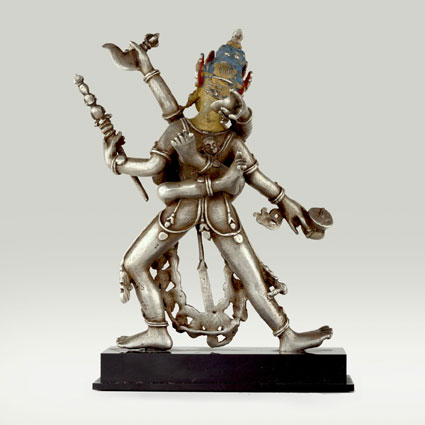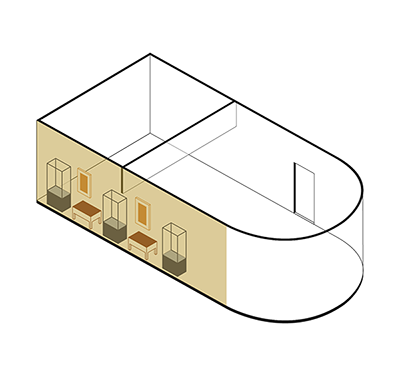ABS 165
Code: ABS 165
Country: Tibet
Style:
Date: 1550 - 1650
Dimensions in cm WxHxD: 10.8 x 14 x 5.1
Materials: Silver alloy
The faces have remains of painted cold gold and the hair are painted with a blue pigment.
The separately cast lotus pedestal is lost.
This sculpture depicts a particular four armed form of Heruka (Tib. He ru ka) united with his consort. Heruka is stepping ti the left with the left leg bent and the right one straight (alidhasana). The principal hands. Turned inwards, holding the five-pronged diamond sceptre (vajra) and the prayer-bell (ghanta), are crossed over the chest and embrace his consort (prajnalingabhinaya). The remaining pair of hands holds the double drum (damarou) and the ceremonial staff (khatvanga). The consort holds the ritual chopper (karttrka) and a skull-cup (kapala) and has both legs wrapped around the waist of Heruka. Both are naked except for the "five ornaments" (pancamudra), and he wears in addition a long garland of several heads (mundamala) around the neck.
Heruka is a collective name for fierce manifestations of the Thatagatas. These images are identified in this publication either as forms of Hevajra (Tib. Kyai rdo rje), Buddhakapala (Tib. Sangs rgyas lo sdom pa), Mahamaya (Tib. sGyu 'phrul chen po), Samvaram(Tib. bDe mchog), Cakrasamvara (Tib. 'Khor lo sdom pa), or Vajradaka (Tib. rDo rje mkha' 'gro). The sandhanamala (SM) and Nispannayogavali (NSP) contains sadanas of several variations of Cakrasamvara, Mahamaya, samvara, and Vajradaka under various names: with one face and two arms named Samvara (Tib. bFe mchong) (SM 255; CBIT 565, 578, 978, 2276 (73); with three faces and six arms named Vajradhaka (Tib. rDo rje mkha' 'gro), Heruka (tib. He ru ka) (SM250), or Samvara (SM 251), with four faces and four arms named Mahamaya (NSP 9; SM 248), Heruka, Hevajra (SM 239), or Vajradaka (SM 249); with four faces and twelve arms named Sri Cakrasamvara (Tib. dPal 'kor lo sdom pa) or Cakrasamvara (NSP 12; CBI 3, 977, 1048, 2266 (63). There exist other forms of Hevajra.
(From Wikipedia, the free encyclopedia)
Heruka is also a name for the Tantric deity Chakrasamvara.
Heruka (Tib. tRak-thung) "blood drinker", is the name of a category of wrathful deities, enlightened beings in Vajrayana Buddhism that adopt a fierce countenance to benefit sentient beings. Herukas represent the embodiment of indivisible bliss and emptiness.
Derivation of the term
The name "Heruka" is made up of the prefix "he-" meaning "hey!" and "ruka", a rich term implying many levels of subtle meaning - richness, royalty, etc. are implied by "ruka". It is linked to the Sanskrit word "Rc" which is where the name "Rgveda" comes from. The famous bodhisattva of the second chapter of the Mahayanasutra "Sovereign King of Golden Splendour" (suvarnabhasottamendraraja) is called "Ruciraketu" - "He Who Flys the Banner of Riches (ruchira)" - is a lay emanation of a Heruka.
Padmasambhava is quoted in the Bardo Thodol (Antarabhavatantra - "Tibetan Book of the Dead"): "The crucial point is indeed that those who have meditated on the formal description of these Herukakaya ('bodies of Heruka'), and also made offerings and praise to them, or, at the very least, have simply seen their painted and sculpted images, may recognize the forms that arise here and attain moksha (liberation)."
Eight Herukas of the Nyingma Mahayoga
The eight Herukas (Wylie: sgrub pa bka’ brgyad) of the Nyingma mahayoga tradition (and their corresponding sadhanas) are said to have been received by Padmakara from the Eight Vidyadharas (Tib. Rigdzin), or Eight Great Acharyas: Manjushrimitra, Nagarjuna, Vajrahumkara, Vimalamitra, Prabhahasti, Dhanasamskrita, Shintamgarbha and Guhyachandra. They were proficient in the practices of, respectively,
1) Yamantaka (Tib. Jampal Shinje, ’jam dpal sku) the wrathful Manjushri, the deity of body
2) Hayagriva (Tib. Pema Sung, padma gsung) the wrathful Avalokeshvara, the deity of speech
3) Vishuddha/Sri Samyak (Tib. Yangdak Thuk, Wylie: yang dag thugs) the wrathful Vajrapani deity of mind
4) Vajramrita (Tib. Dudtsi Yonten, bdud rtsi yon tan) the wrathful Samantabhadra, the deity of enlightened qualities
5) Vajrakilaya/Vajrakumara (Tib. Dorje Phurba, phur ba ‘phrin las), the wrathful Nivaranavishkambin, the deity of action
6) Matarah (Tib. Mamo Botong, ma mo rbod gtong) the wrathful Akasagarbha, the deity of calling and dispatching
7) Lokastotrapuja-natha (Tib. Jigten Chotod, ’jig rten mchod bstod) the wrathful Ksitigarbha, the deity of worldly offering and praise
8) Vajramantrabhiru (Tib. Mopa Dragnak, mod pa drag sngags) the wrathful Maitreya, the deity of wrathful mantras
References
Gyatso, Geshe Kelsang. Essence of Vajrayana. New York: Tharpa Publications, 2003 ISBN 0-948006-48-X.
Bhattacharyya, Benoytosh , 1958. Indian Buddhist Iconography. Calcutta: K. L. Mukhopadhyay. Pp. 160-162 - References to the iconography of Samvara and Cakrasamvara
Chandra, Lokesh, 1996. Thangka-Kalender 1987. Haldenwang: Edition Schangrila. Nos. 3, 536, 565, 578, 978, 1048, 2266 (63) - References to the iconography of Samvara and Cakrasamvara
Cornu, Philippe , 2001. Dictionnaire Encyclopédique du Bouddhisme. Seuil. P. 323 - Références françaises: Heruka
de Mallmann, Marie-Thérèse, 1975. Introduction à l'iconographie du tântrisme bouddhique. Paris: Adrien Mainsonneuve (Jean Maisonneuve successeur (1970). Pp. 182-190 - References to the iconography of Samvara and Cakrasamvara
Huntington, Susan L. and John C., 1990. Leaves from the Bodhi Tree: The Art of Påla India (8th–12th centuries) and Its International Legacy, [catalogue of the exhibition held at the Dayton Art Institute, Dayton, Ohio]. Seattle & London: University of Washington Press. Pp. 535-540 - References to the iconography of Samvara and Cakrasamvara





